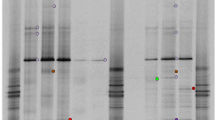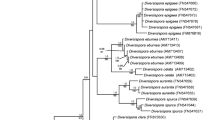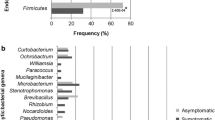Abstract
The spores of arbuscular mycorrhizal fungi (AMF) form a unique microhabitat that is suitable for the colonization by many species of bacteria. The aim of the current study was to analyze the bacterial communities associated with the surface of spores of the AMF species Gigaspora margarita MAFF 520054 and Gigaspora rosea JP1. The two AMF species were propagated with tobacco (Nicotiana tabacum) grown in a mixture of sand and soil. In another experiment, G. margarita was propagated with tobacco or alfalfa (Medicago sativa) grown in vermiculite or a mixture of sand and soil. The bacterial community composition of the new-formed spores and sand/soil substrate was analyzed using PCR of 16S rDNA fragments and denaturing gradient gel electrophoresis (DGGE). Clustering analysis revealed that the bacterial communities on the surface of G. margarita spores was different form that in the substrate or on the surface of the G. rosea spores, and both the host plant and the substrate could influence the composition of spore-associated bacterial populations of the G. margarita. Sequence analysis of the major DGGE bands of G. margarita spore samples revealed that most of the bacterial sequences were affiliated with the phyla Proteobacteria (Azospirillum, Azovibrio, Polyangium, Ramlibacter, Rubrivivax, Sphingomonas, and Rhizobium) and Actinobacteria (Streptomyces, Amycolatopsis, and Pseudonocardia).





Similar content being viewed by others
References
Ames RN, Mihara KL, Bayne HG (1989) Chitin-decomposing actinomycetes associated with a vesicular-arbuscular mycorrhizal fungus from a calcareous soil. New Phytol 111:67–71
Andrade G, Linderman RG, Bethlenfalvay GJ (1998) Bacterial associations with the mycorrhizosphere and hyphosphere of the arbuscular mycorrhizal fungus Glomus mosseae. Plant Soil 202:79–87
Artursson V, Finlay RD, Jansson JK (2006) Interactions between arbuscular mycorrhizal fungi and bacteria and their potential for stimulating plant growth. Environ Microbiol 8:1–10
Bianciotto V, Bandi C, Minerdi D, Sironi M, Tichy HV, Bonfante P (1996) An obligately endosymbiotic mycorrhizal fungus itself harbors obligately intracellular bacteria. Appl Environ Microb 62:3005–3010
Bianciotto V, Lumini E, Bonfante P, Vandamme P (2003) ‘Candidatus Glomeribacter gigasporarum’, gen. nov., sp. nov., an endosymbiont of arbuscular mycorrhizal fungi. Int J Syst Evol Microbiol 53:121–124
Brosius J, Dull TJ, Sleeter DD, Noller HF (1981) Gene organization and primary structure of a ribosomal DNA operon from Escherichia coli. J Mol Biol 148:107–127
Carpenter-Boggs L, Loynachan TE, Stahl PD (1995) Spore germination of Gigaspora margarita stimulated by volatiles of soil-isolated actinomycetes. Soil Biol Biochem 27:1445–1451
Cocolin L, Manzano M, Cantoni C, Comi G (2001) Denaturing gradient gel electrophoresis anlysis of the 16S rRNA gene V1 region to monitor dynamic changes in the bacterial population during fermentation of Italian sausages. Appl Environ Microb 67(11):5113–5121
Cruz AF, Horii S, Ochiai S, Yasuda A, Ishii T (2008) Isolation and analysis of bacteria associated with spores of Gigaspora margarita. J Appl Microbiol 104(6):1711–1717
Garbaye J (1994) Helper bacteria: a new dimension to the mycorrhizal symbiosis. New Phytol 128:197–210
Fromin N, Hamelin J, Tarnawski S, Roesti D, Jourdain-Miserez K, Forestier N, Teyssier-Cuvelle S, Gillet F, Aragno M, Rossi P (2002) Statistical analysis of denaturing gel electrophoresis (DGE) fingerprinting patterns. Environ Microbiol 4:634–643
Hildebrandt U, Janetta K, Bethe H (2002) Towards growth of arbuscular mycorrhizal fungi independent of a plant host. Appl Environ Microb 68:1919–1924
Hildebrandt U, Ouziad F, Marner F-J, Bothe H (2006) The bacterium Paenibacillus validus stimulates growth of the arbuscular mycorrhizal fungus Glomus intraradices up to the formation of fertile spores. FEMS Microbiol Lett 254:258–267
Jargeat P, Cosseau C, Ola’h B, Jauneau A, Bonfante P, Batut J, Bécard G (2004) Isolation, free-living capacities, and genome structure of “Candidatus Glomeribacter gigasporarum,” the endocellular bacterium of the mycorrhizal fungus Gigaspora margarita. J Bacteriol 186:6876–6884
Johansson JF, Paul LR, Finlay RD (2004) Microbial interactions in the mycorrhizosphere and their significance for sustainable agriculture. FEMS Microbiol Ecol 48:1–13
Kirk JL, Beaudette LA, Hart M, Moutoglis P, Klironomos JN, Lee H, Trevors JT (2004) Methods of studying soil microbial diversity. J Microbiol Meth 58:169–188
Koide RT, Mosse B (2004) A history of research on arbuscular mycorrhiza. Mycorrhiza 14:145–163
Lee PJ, Koske RE (1994) Gigaspora gigantea-parasitism of spores by fungi and actinomycetes. Mycol Res 98:458–466
Macdonald RM, Chandler MR (1981) Bacterium-like organelles in the vesicular-arbuscular mycorrhizal fungus Glomus caledonius. New Phytol 89:241–246
Maia LC, Kimbrough JW (1998) Ultrastructural studies of spores and hypha of a Glomus species. Int J Plant Sci 159:581–589
Mamatha G, Bagyaraj DJ, Jaganath S (2002) Inoculation of fileld-established mulberry and papaya with arbucular mycorrhizal fungi and a mycorrhiza helper bacterium. Mycorrhiza 12:313–316
Mayo K, Davis RE, Motta J (1986) Stimulation of germination of spores of Glomus versiforme by spore-associated bacteria. Mycologia 78:426–431
Muyzer G, Waal ECD, Uitterlinden AG (1993) Profiling of complex microbial populations by denaturing gradient gel electrophoresis analysis of polymerase chain reaction-amplified genes coding for 16S rRNA. Appl Environ Microb 59(3):695–700
Powell CL, Bagyaraj DJ (1984) VA mycorrhiza. CRC, USA, pp 35–223
Roesti D, Ineichen K, Braissant O, Redecker D, Wiemken A, Aragno M (2005) Bacteria associated with spores of the arbuscular mycorrhizal fungi Glomus geosporum and Glomus constrictum. Appl Environ Microb 71:6673–6679
Sambrook J, Fritsch EF, Maniatis T (1989) Molecular cloning: a laboratory manual, 2nd edn. Cold Spring Harbor Laboratory Press, USA
Walley FL, Germida JJ (1996) Failure to decontaminate Glomus clarum NT4 spores is due to spore wall-associated bacteria. Mycorrhiza 6:43–49
Xavier LJC, Germida JJ (2003) Bacteria associated with Glomus clarum spores influence mycorrhizal activity. Soil Biol Biochem 35:471–478
Yeates C, Gillings MR, Davison AD, Altavilla N, Veal DA (1998) Methods for microbial DNA extraction from soil for PCR amplification. Biol Proced Online 1:40–47
Acknowledgments
Financial support was provided by the Natural Science Foundation of Guangdong Province, China (No. E05202480, 07000509).
Author information
Authors and Affiliations
Corresponding author
Additional information
Responsible Editor: David E. Crowley.
Rights and permissions
About this article
Cite this article
Long, L., Zhu, H., Yao, Q. et al. Analysis of bacterial communities associated with spores of Gigaspora margarita and Gigaspora rosea . Plant Soil 310, 1–9 (2008). https://doi.org/10.1007/s11104-008-9611-7
Received:
Accepted:
Published:
Issue Date:
DOI: https://doi.org/10.1007/s11104-008-9611-7




